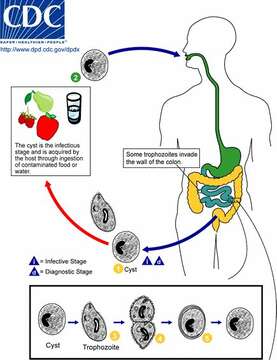Life cycle of Balantidium coli, the cause of human balantidiasis

Kuvaus:
Life cycle of Balantidium coli, the cause of human balantidiasis
The cyst stage (1) of the B. coli life cycle is responsible for transmission.The host most often acquires the cyst through ingestion of contaminated food or water (2). Following ingestion, excystation occurs in the small intestine and the trophozoites colonize the large intestine (3). The trophozoites reside in the lumen of the large intestine of humans and other animals, where they reproduce by binary fission, during which conjugation may occur (4). Trophozoites undergo encystation to produce infective cysts (5). Some trophozoites invade the wall of the colon and multiply. Some return to the lumen and disintegrate. Mature cysts are passed with feces (1).
From Centers for Disease Control Parasites and Health website
Mukana seuraavilla sivuilla:
- Life
- Cellular
- Eukaryota (aitotumaiset)
- SAR (Stramenopiles, Alveolates, Rhizaria)
- Alveolata (Alveolaatit)
- Ciliophora (Ripsieläimet)
- Intramacronucleata
- Litostomatea
- Trichostomatia
- Vestibuliferida
- Balantidiidae
- Balantidium
- Balantidium coli
Tämä kuva ei ole esillä missään kokoelmassa.
Lähdetiedot
- lisenssi
- cc-by-nc
- tekijänoikeus
- Centers for Disease Control/Division of Parasitic Diseases and Malaria
- julkaisija
- Shapiro, Leo
- valokuvaaja
- Centers for Disease Control/Division of Parasitic Diseases and Malaria
- tarjoaja
- EOL Rapid Response Team
- alkuperäinen
- alkuperäinen mediatiedosto
- käy lähteessä
- kumppanisivusto
- EOL staff
- ID


